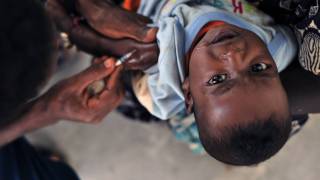197 Mumps Cases Reported at 3 ICE Facilities During 2019

A mumps virus outbreak at the Pine Prairie Immigration and Customs Enforcement (ICE) Processing Center in Louisiana has reached 18 cases during 2019.
According to Kaiser Health News (KHN) on March 6, 2019, the Pine Prairie facility reported:
- 6 likely/confirmed case of mumps before January 15
- 7 cases were reported between January 15th and 30th
- 5 cases were reported during February 2019
The Centers for Disease Control and Prevention (CDC) did not respond to KHN’s reporters Shefali Luthra and Julie Appleby requests for information regarding mumps cases nationally at ICE centers.
According to previous, unofficial reports, the number of ICE detainees with mumps during 2019 now total 197 cases:
- Louisiana: 18 cases
- Colorado: 1 confirmed case
- Texas: 178 confirmed cases
Colorado Department of Public Health and Environment (CDPHE) staff say that mumps is being brought to their ICE facility by detainees from Central America.
"The vaccine that was given in Central America focused on just measles and rubella until the mid-’90s," says Rachel Herlihy, MPH, a communicable-disease epidemiologist.
This means those who received this vaccination before the mid-90s were not immunized against the mumps virus.
KNH said this Louisiana mumps outbreak is one of several at ICE detention centers nationally. In the past year, ICE confirmed to KHN that 51 of its facilities have reported investigations into mumps, chicken pox, and influenza.
The Pine Prairie ICE facility is located 100-miles northwest of Baton Rouge and holds about 700 immigrants.
Pine Prairie detention center officials told lawyers that a ‘dorm lockdown’ was aimed at preventing the spread of mumps throughout the facility, which has an incubation period of 12 to 25 days.
The restriction applied to detainees who may have been exposed to the virus as well as people who had confirmed infections, these attorneys told KHN.
And, if new mumps cases emerge in a quarantined dorm, the lockdown clock of 12 to 25 days re-starts.
ICE’s Health Service Corps (IHSC), provides care for a range of medical conditions that are often associated with transitory living conditions, lack of resources, or the perils of their travels.
IHSC Medical Case Management Unit Chief Capt. Lori B. Hanton emphasized during 2016 that IHSC’s work was focused on patient care, “IHSC is there for the detainees; our job is to make sure they get the care they need.”
But individual ICE facilities are given the freedom to design their own protocols, the spokesman added.
Overall, the incidence of mumps in the civilian population remains low. From January 1 to 31, 2019, 18 US states reported mumps infections in 58 people to the CDC.
Mumps is best known for the puffy cheeks and swollen jaw that it causes. This is a result of swollen salivary glands. Mumps can occasionally cause complications, especially in adults. Complications include inflammation of the testicles, inflammation of the brain, meningitis, and deafness, says the CDC.
To get infected, a person generally has to be in close contact with an infected person.
As an example, In 2016-17, a large mumps outbreak in a close-knit community in northwest Arkansas resulted in nearly 3,000 cases.
In response to the expanding number of mumps outbreaks in the USA, the CDC released guidance in October 2017, regarding when the 3rd dose of mumps vaccine is appropriate, such as a ‘confirmed outbreak’.
The MMR vaccine prevents most, but not all, cases of mumps and complications caused by the disease. The mumps component of the MMR vaccine has reported being 88 percent effective when a person gets 2 vaccine doses.
Vaccines, like any medicine, can have side effects, says the CDC. You are encouraged to report negative side effects of vaccines to the FDA or CDC.
Our Trust Standards: Medical Advisory Committee


























